Tag: American history
Primary Sources: Confederate Slave Payrolls
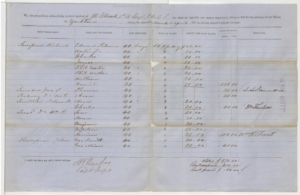 The National Archives recently released a digitized collection of Confederate Slave Payrolls, 1861-1865 that are part of Record Group 109, War Department Collection of Confederate Records. The records list the names and locations of the slaves whose labor was leased to the Confederacy for a variety of tasks, including digging entrenchments, creating obstructions on rivers, digging potassium nitrate for gunpowder, and providing labor at ordnance factories and arsenals. The payrolls provide the name and usually the place of residence of each slave owner. The information provided about the slave included his or her name, date and place employed, occupation, number of days worked, daily rate of pay, total amount of pay, and name of the Confederate Officer responsible for the payroll. The article “Civil War Confederate Slave Payroll Records” provides more information about the content and organization of the records.
The National Archives recently released a digitized collection of Confederate Slave Payrolls, 1861-1865 that are part of Record Group 109, War Department Collection of Confederate Records. The records list the names and locations of the slaves whose labor was leased to the Confederacy for a variety of tasks, including digging entrenchments, creating obstructions on rivers, digging potassium nitrate for gunpowder, and providing labor at ordnance factories and arsenals. The payrolls provide the name and usually the place of residence of each slave owner. The information provided about the slave included his or her name, date and place employed, occupation, number of days worked, daily rate of pay, total amount of pay, and name of the Confederate Officer responsible for the payroll. The article “Civil War Confederate Slave Payroll Records” provides more information about the content and organization of the records.
Primary Sources: Black Thought and Culture
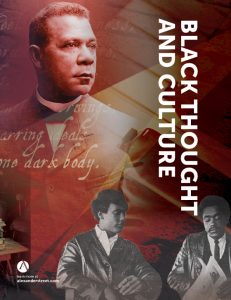 The Library recently acquired Black Thought and Culture, an electronic collection of approximately 100,000 pages of non-fiction writings by major American black leaders, covering 250 years of history. It also includes a great deal of previously inaccessible material, including letters, speeches, political leaflets, interviews, periodicals, and trial transcripts. Highlights include:
The Library recently acquired Black Thought and Culture, an electronic collection of approximately 100,000 pages of non-fiction writings by major American black leaders, covering 250 years of history. It also includes a great deal of previously inaccessible material, including letters, speeches, political leaflets, interviews, periodicals, and trial transcripts. Highlights include:
- The transcript of the Muhammad Ali trial
- A full run of The Black Panther newspaper, with full-color images of every page as well as searchable text
- 2,500 pages of exclusive Black Panther oral histories owned by the Dr. Huey P. Newton Foundation
Primary Sources: Leftist Historical Newspapers and Periodicals and Communist Historical Newspapers
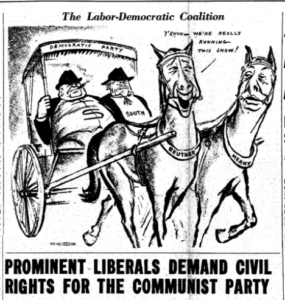 ProQuest’s Leftist Historical Newspapers and Periodicals includes publications supporting the ideology of communism, most published in the United States and United Kingdom. Dates of coverage range from 1848 to 1978, with most coverage in the early 20th century. Complete runs of some publications are not available.
ProQuest’s Leftist Historical Newspapers and Periodicals includes publications supporting the ideology of communism, most published in the United States and United Kingdom. Dates of coverage range from 1848 to 1978, with most coverage in the early 20th century. Complete runs of some publications are not available.
The Communist Historical Newspaper Collection provides full-text access to major American communist newspapers. Includes The Daily Worker (1924-1958); The Ohio Socialist (1917-1919); People’s Daily World (1986-1990); People’s Weekly World (1990-2013); Sunday Worker (1936-1958); The Toiler (1919-1922); The Worker (1922-1924); The Worker (1958-1968).
Primary Sources: Immigration and Migration resources
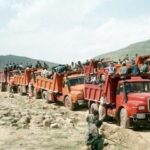 Border and Migration Studies Online is a collection that explores and provides historical background on more than thirty key worldwide border areas. Featuring at completion 100,000 pages of text, 175 hours of video, and 1,000 images, the collection is organized around fundamental themes associated with border and migration issues, such as border identities, sea migration, maritime borders, etc.
Border and Migration Studies Online is a collection that explores and provides historical background on more than thirty key worldwide border areas. Featuring at completion 100,000 pages of text, 175 hours of video, and 1,000 images, the collection is organized around fundamental themes associated with border and migration issues, such as border identities, sea migration, maritime borders, etc.
Immigration Records of the INS: 1880-1930 covers the investigations made by the Immigration and Naturalization Service (INS) during the massive immigration wave of 1880-1930. The files cover Asian immigration, especially Japanese and Chinese migration, to California, Hawaii, and other states; Mexican immigration to the U.S. from 1906-1930, and European immigration. There are also extensive files on the INS’s regulation of prostitution and white slavery and on suppression of radical aliens.
Trial: Crime, Punishment, and Popular Culture
Until September 20th the Library has access to Gale’s online archive, Crime, Punishment, and Popular Culture, 1790-1920, comprising more than 2 million pages. It contains manuscripts, books, broadsheets, and periodicals sources from institutions in the UK and United States. Some of the printed matter is very scarce, such as Mary Fortune’s 1871 The Detective’s Album, a pioneering police procedural by a woman author, of which only two hard copies survive. Other material has been held in archives, often widely dispersed, and not always readily accessible to the researcher.
Primary Sources: Federal Surveillance of African Americans, 1920-1984
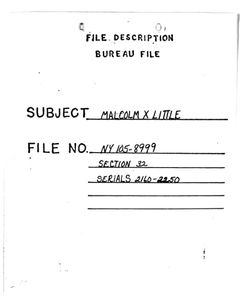 “Throughout the twentieth century Black Americans of all political persuasions were subject to federal scrutiny, harassment, and prosecution. The Federal Bureau of Investigation enlisted black “confidential special informants” to infiltrate a variety of organizations. Hundreds of documents in this collection were originated by such operatives. The reports provide a wealth of detail on “Negro” radicals and their organizations. In addition to infiltration, the FBI contributed to the infringement of First Amendment freedoms by making its agents a constant visible presence at radical rallies and meetings. This archive is based on original microfilm.”
“Throughout the twentieth century Black Americans of all political persuasions were subject to federal scrutiny, harassment, and prosecution. The Federal Bureau of Investigation enlisted black “confidential special informants” to infiltrate a variety of organizations. Hundreds of documents in this collection were originated by such operatives. The reports provide a wealth of detail on “Negro” radicals and their organizations. In addition to infiltration, the FBI contributed to the infringement of First Amendment freedoms by making its agents a constant visible presence at radical rallies and meetings. This archive is based on original microfilm.”
It contains the FBI files on A. Philip Randolph, Adam Clayton Powell, the Atlanta Child Murders, the Black Panther Party-North Carolina, the Committee for Public Justice, Elijah Muhammed, the Highlander Folk School, the Ku Klux Klan Murder of Viola Liuzzo, Malcolm X, MIBURN (Mississippi Burning), the Moorish Science Temple of America, the Murder of Lemuel Penn, Muslim Mosque, Inc., the NAACP, the National Negro Congress, the Organization of Afro-American Unity, Paul Robeson, the Reverend Jesse Jackson, Roy Wilkins, the Student Nonviolent Coordinating Committee, Thurgood Marshall, W.E.B. Du Bois, Communist Infiltration of the Southern Christian Leadership Conference, and Marcus Garvey.
Resource: Oxford Research Encyclopedias: American History and Latin American History
 The Library has recently acquired the Oxford Research Encyclopedia of American History and the Oxford Research Encyclopedia of Latin American History, two online resources that provide peer-reviewed and regularly updated essays, as well as links to visual and primary source materials.
The Library has recently acquired the Oxford Research Encyclopedia of American History and the Oxford Research Encyclopedia of Latin American History, two online resources that provide peer-reviewed and regularly updated essays, as well as links to visual and primary source materials.
Trial: America in World War Two: Oral Histories and Personal Accounts
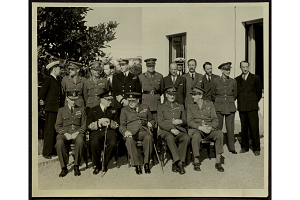 The Library currently has trial access to the Adam Matthew Digital resource, America in World War Two: Oral Histories and Personal Accounts. The collections included in the digital archive are sourced from the National World War II Museum in New Orleans. The publisher states: “Our aim has been to digitize a sizeable proportion of these collections, which document the sweeping narrative of the American experience in this global conflict. In close collaboration with the Museum and with valuable input from our scholarly, editorial board, we have showcased hundreds of archive collections, oral histories and objects. For document collections we have focused on archive content, containing primarily, but not exclusively, diaries, correspondence, scrapbooks, training manuals, periodicals, albums, sketches, greetings cards and photographs. We have also included some rare books, as well as a honed selection of objects, which act as a representative sample of items in the individual collections we have chosen, as well as some choice objects featured in the museum galleries that complement our key themes.”
The Library currently has trial access to the Adam Matthew Digital resource, America in World War Two: Oral Histories and Personal Accounts. The collections included in the digital archive are sourced from the National World War II Museum in New Orleans. The publisher states: “Our aim has been to digitize a sizeable proportion of these collections, which document the sweeping narrative of the American experience in this global conflict. In close collaboration with the Museum and with valuable input from our scholarly, editorial board, we have showcased hundreds of archive collections, oral histories and objects. For document collections we have focused on archive content, containing primarily, but not exclusively, diaries, correspondence, scrapbooks, training manuals, periodicals, albums, sketches, greetings cards and photographs. We have also included some rare books, as well as a honed selection of objects, which act as a representative sample of items in the individual collections we have chosen, as well as some choice objects featured in the museum galleries that complement our key themes.”
Access to the resource ends September 27th. During the trial you will not be able to download documents. Please send your feedback to dorner@berkeley.edu.
Primary Sources: National Farm Worker Ministry: Mobilizing Support for Migrant Workers, 1939-1985
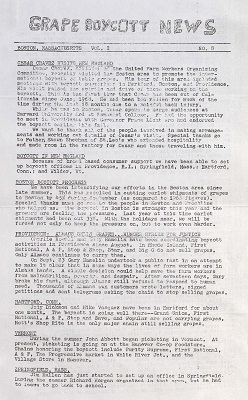 Another recent acquisition of the Library is the online archive National Farm Worker Ministry: Mobilizing Support for Migrant Workers, 1939-1985. These records of the California Migrant Ministry, which became the National Farm Worker Ministry, are part of the Archives of Labor and Urban Affairs housed at Wayne State University’s Walter P. Reuther Library.
Another recent acquisition of the Library is the online archive National Farm Worker Ministry: Mobilizing Support for Migrant Workers, 1939-1985. These records of the California Migrant Ministry, which became the National Farm Worker Ministry, are part of the Archives of Labor and Urban Affairs housed at Wayne State University’s Walter P. Reuther Library.
This collection reproduces correspondence, reports, speeches, minutes; included are materials relating to the farm workers, poverty programs, Public Law 78, Braceros, labor camps, the United Farm Workers Union and the Delano Grape Strike. The landing page for the online archive includes a descriptive list of contents.
Let There Be Light podcast explores identity at UC Berkeley — through housing, microchips, and the Berkeley food scene
Announcing Season 4 of the Berkeley Remix podcast!
This season of the Berkeley Remix we’re bringing to life stories about our home — UC Berkeley — from our collection of thousands of oral histories. Please join us for our fourth season, Let There Be Light: 150 Years at UC Berkeley, inspired by the University’s motto, Fiat Lux. Our episodes this season explore issues of identity — where we’ve been, who we are now, the powerful impact Berkeley’s identity as a public institution has had on student and academic life, and the intertwined history of campus and community.
The three-episode season explores how housing has been on the front lines of the battle for student welfare throughout the University’s history; how UC Berkeley created a culture of innovation that made game-changing technologies possible; and how political activism on campus was a motivator for the farm-to-table food scene in the city of Berkeley. All episodes include audio from interviews from the Oral History Center of The Bancroft Library.
Episode 1. Sleeping with the Light On: Housing and Community at Berkeley
Written and produced by historian Amanda Tewes, UC Berkeley Oral History Center
“From early housing cooperatives during the Great Depression, to fights for racial and gender parity on campus, housing has been on the front lines of the battle for student welfare throughout the University’s history.”
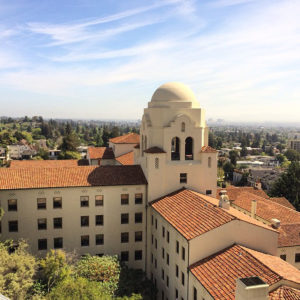
We’ve come to think of communal living as a tradition for students, a rite of passage and a valuable lesson in community building. But for much of its history, UC Berkeley didn’t even have residence halls! In this episode, we explore what home and community has meant to students at Cal, and how accessible spaces have supported social justice movements on and beyond campus.
This episode includes audio from the Oral History Center of The Bancroft Library, including Rev. Allen C. Blaisdell, Jackie Goldberg, Frank Inami, Marguerite Kulp Johnston, Edward V. Roberts, and Dorothy Walker. Voiceover of Ruth Norton Donnelly’s interview by Shanna Farrell. Audio from the “Which Campus?” video courtesy of The Bancroft Library. (Written version of Sleeping with the Light On.)
Episode 2. Berkeley Lightning: A Public University’s Role in the Rise of Silicon Valley
Written and produced by historian Paul Burnett, UC Berkeley Oral History Center
“We’re used to hearing about how game-changing technology makes whole new ways of living and working possible. But what makes the game-changing technologies possible? UC Berkeley — a public, state university — established institutions and teams that would make the culture of innovation possible.”

“Berkeley Lightning” is about the contributions of UC Berkeley Engineering to the rise of the semiconductor industry in what became known as Silicon Valley in the 1960s and 70s. In contrast to the influential entrepreneurial spirit of a private university like Stanford, Berkeley’s status as a public institution had a different impact on Silicon Valley. We focus on the development of the first widely used design program for prototyping microchips. Originally designed by and for students, the software spread like lightning in part because Berkeley, as a public institution, made it available free of charge. The world has not been the same since.
This episode includes audio from the Oral History Center of The Bancroft Library, including Paul R. Gray, Professor of Engineering Emeritus, Department of Electrical Engineering and Computer Science and Dr. Laurence Nagel, CEO Omega Enterprises, PhD from UC Berkeley EECS, and former senior manager at Bell Laboratories (oral history forthcoming). (Written version of Berkeley Lightning.)
Episode 3. Berkeley After Dark
Written and produced by interviewer Shanna Farrell, UC Berkeley Oral History Center
“What Alice Waters and the Chez Panisse team did was probably the most radical gesture in restaurants and cooking in America in the last century. It’s important that it happened in Berkeley.” — Chef Christopher Lee
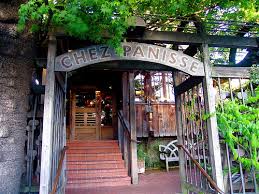
Berkeley After Dark is about the connection between the history of farm-to-table eating and the campus community. UC Berkeley alum Alice Waters helped pioneer the concept of eating local, seasonal, and organic food at her restaurant, Chez Panisse, located just a few blocks from campus on Shattuck Avenue. This grew out of her combined love of feeding people and political activism, and evolved into a culinary revolution. And it couldn’t have happened without UC Berkeley. The intertwined history between campus and the community gave Chez Panisse an audience, and a workforce, creating a symbiotic relationship.
This episode includes audio from the Oral History Center of The Bancroft Library, including Christopher Lee, Narsai David, and Dylan O’Brien. Voiceover of Marion Cunningham’s interview by Amanda Tewes and Paul Bertolli’s interview by John Fragola. Supplemental interviews with Chris Ying. (Written version of Berkeley After Dark.)
Over the decades, the Oral History Center has conducted 4,000 interviews on almost every topic imaginable. As part of UC Berkeley’s commitment to open access, the transcripts are available to researchers and the public at no cost, and almost all of the transcripts are available online. Search our vast collection.